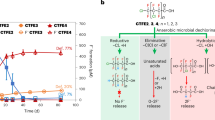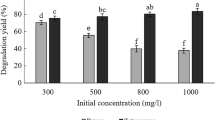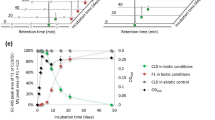Abstract
Tetrachloroethylene (PCE) is thought to have no natural source, so it is one of the most difficult contaminants to degrade biologically. This common groundwater pollutant was thought completely nonbiodegradable in the presence of oxygen. Here we report that the wastewater bacterium Pseudomonas stutzeri OX1 degrades aerobically 0.56 μmol of 2.0 μmol PCE in 21 h (Vmax ≈ 2.5 nmol min−1 mg−1 protein and KM ≈ 34 μM). These results were corroborated by the generation of 0.48 μmol of the degradation product, chloride ions. This degradation was confirmed to be a result of expression of toluene-o-xylene monooxygenase (ToMO) by P. stutzeri OX1, since cloning and expressing this enzyme in Escherichia coli led to the aerobic degradation of 0.19 μmol of 2.0 μmol PCE and the generation of stoichiometric amounts of chloride. In addition, PCE induces formation of ToMO, which leads to its own degradation in P. stutzeri OX1. Degradation intermediates reduce the growth rate of this strain by 27%.
This is a preview of subscription content, access via your institution
Access options
Subscribe to this journal
Receive 12 print issues and online access
$209.00 per year
only $17.42 per issue
Buy this article
- Purchase on Springer Link
- Instant access to full article PDF
Prices may be subject to local taxes which are calculated during checkout
Similar content being viewed by others
References
Westrick, J.J., Mello, J.W. & Thomas, R.F. The groundwater supply survey. J. Am. Water Works Assoc. 76, 52–59 (1984).
Carter, S.R. & Jewell, W.J. Biotransformation of tetrachloroethylene by anaerobic attached-films at low temperatures. Water Res. 27, 607–615 (1993).
Leung, S.W., Watts, R.J. & Miller, G.C. Degradation of perchloroethylene by Fenton's reagent: speciation and pathway. J. Environ. Qual. 21, 377–381 (1992).
McCarty, P.L. Breathing with chlorinated solvents. Science 276, 1521–1522 (1997).
Maymo-Gatell, X., Chien, Y.-T., Gossett, J.M. & Zinder, S.H. Isolation of a bacterium that reductively dechlorinates tetrachloroethene to ethene. Science 276, 1568–1571 (1997).
Ensley, B.D. Biochemical diversity of trichloroethylene metabolism. Annu. Rev. Microbiol. 45, 283–299 (1991).
Fox, B.G., Borneman, J.G., Wackett, L.P. & Lipscomb, J.D. Haloalkene oxidation by the soluble methane monooxygenase from Methylosinus trichosporium OB3b: mechanistic and environmental implications. Biochem. 29, 6419–6427 (1990).
Sharma, P.K. & McCarty, P.L. Isolation and characterization of a facultatively aerobic bacterium that reductively dehalogenates tetrachloroethene to cis-1,2-dichloroethene. Appl. Environ. Microbiol. 62, 761–765 (1996).
Bradley, P.M. & Chapelle, F.H. Effect of contaminant concentration on aerobic microbial mineralization of DCE and VC in stream-bed sediments. Environ. Sci. Technol. 32, 553–557 (1998).
Baggi, G., Barbieri, P., Galli, E. & Tollari, S. Isolation of a Pseudomonas stutzeri strain that degrades o-xylene. Appl. Environ. Microbiol. 53, 2129–2132 (1987).
Bertoni, G., Bolognese, F., Galli, E. & Barbieri, P. Cloning of the genes for and characterization of the early stages of toluene and o-xylene catabolism in Pseudomonas stutzeri OX1. Appl. Environ. Microbiol. 62, 3704–3711 (1996).
Chauhan, S., Barbieri, P. & Wood, T.K. Oxidation of trichloroethylene, 1,1-dichloroethylene, and chloroform by toluene/o-monooxygenase from Pseudomonas stutzeri OX1. Appl. Environ. Microbiol. 64, 3023–3024 (1998).
Shim, H. & Wood, T.K. Aerobic degradation of mixtures of chlorinated aliphatics by cloned tolune-o-xylene monooxygenase and tolune-o-monooxygenase in resting cells. Biotechnol. Bioeng., in press (2000).
Bertoni, G., Martino, M., Galli, E. & Barbieri, P. Analysis of the gene cluster encoding toluene/o- xylene monooxygenase from Pseudomonas stutzeri OX1. Appl. Environ. Microbiol. 64, 3626–3632 (1998).
Sun, A.K. & Wood, T.K. Trichloroethylene degradation and mineralization by pseudomonads and Methylosinus trichosporium OB3b. App. Microbiol. Biotechnol. 45, 248–256 (1996).
Nelson, M.J.K., Montgomery, S.O., Mahaffey, W.R. & Pritchard, P.H. Biodegradation of trichloroethylene and involvement of an aromatic biodegradative pathway. Appl. Environ. Microbiol. 53, 949–954 (1987).
Van Hylckama Vlieg, J.E.T., de Koning, W. & Janssen, D.B. Transformation kinetics of chlorinated ethenes by Methylosinus trichosporium OB3b and detection of unstable epoxides by on-line gas chromatography. Appl. Environ. Microbiol. 62, 3304–3312 (1996).
Newman, L.M. & Wackett, L.P. Trichloroethylene oxidation by purified toluene 2-monooxygenase: products, kinetics, and turnover-dependent inactivation. J. Bacteriol. 179, 90–96 (1997).
Mars, A.E., Houwing, J., Dolfing, J. & Janssen, D.B. Degradation of toluene and trichloroethylene by Burkholderia cepacia G4 in growth-limited fed-batch culture. Appl. Environ. Microbiol. 62, 886–891 (1996).
Wackett, L.P. & Householder, S.R. Toxicity of trichloroethylene to Pseudomonas putida F1 is mediated by toluene dioxygenase. Appl. Environ. Microbiol. 55, 2723–2725 (1989).
Arenghi, F.L.G., Pinti, M., Galli, E. & Barbieri, P. Identification of the Pseudomonas stutzeri OX1 toluene-o-xylene monooxygenase regulatory gene (touR) and its cognate promoter. Appl. Environ. Microbiol. 65, 4057–4063 (1999).
McClay, K., Streger, S.H. & Steffan, R.J. Induction of toluene oxidation activity in Pseudomonas mendocina KR1 and Pseudomonas sp. strain ENVPC5 by chlorinated Solvents and alkanes. Appl. Environ. Microbiol. 61, 3479–3481 (1995).
Heald, S. & Jenkins, R.O. Trichloroethylene removal and oxidation toxicity mediated by toluene dioxygenase of Pseudomonas putida. Appl. Environ. Microbiol. 60, 4634–4637 (1994).
Shingleton, J.T., Applegate, B.M., Nagel, A.C., Bienkowski, P.R. & Sayler, G.S. Induction of the tod operon by trichloroethylene in Pseudomonas putida TVA8. Appl. Environ. Microbiol. 64, 5049–5052 (1998).
Holliger, C., Schraa, G., Stams, A.J.M. & Zehnder, A.J.B. A highly purified enrichment culture couples the reductive dechlorination of tetrachloroethene to growth. Appl. Environ. Microbiol. 59, 2991–2997 (1993).
Sambrook, J., Fritsch, E.F. & Maniatis, T. Molecular cloning, a laboratory manual. (Cold Spring Harbor Laboratory Press, Cold Spring Harbor, NY; 1989).
Luu, P.P., Yung, C.W., Sun, A.K.-Y. & Wood, T.K. Monitoring trichloroethylene mineralization by Pseudomonas cepacia G4 PR1. Appl. Microbiol. Biotechnol. 44, 259–264 (1995).
Bolognese, F., di Lecce, C., Galli, E. & Barbieri, P. Activation and inactivation of Pseudomonas stutzeri methylbenzene catabolism pathways mediated by a transposable element. Appl. Environ. Microbiol. 65, 1876–1882 (1999).
Yee, D.C., Maynard, J.A. & Wood, T.K. Rhizoremediation of trichloroethylene by a recombinant, root-colonizing Pseudomonas fluorescens strain expressing toluene ortho-monooxygenase constitutively. Appl. Environ. Microbiol. 64, 112–118 (1998).
Shields, M.S., Reagin, M.J., Gerger, R.R., Campbell, R. & Somerville, C. TOM, a new aromatic degradative plasmid from Burkholderia (Pseudomonas) cepacia G4. Appl. Environ. Microbiol. 61, 1352–1356 (1995).
Mercer, J.W. & Cohen, R.M. A review of immiscible fluids in the subsurface: properties, models, characterization and remediation. J. Contam. Hydrol. 6, 107–163 (1990).
Bergmann, J.G. & Sanik, J. Determination of trace amounts of chlorine in naptha. Anal. Chem. 29, 241–243 (1957).
Phelps, P.A., Agarwal, S.K., Speitel, G.E. & Georgiou, G. Methylosinus trichosporium OB3b mutants having constitutive expression of soluble methane monooxygenase in the presence of high levels of copper. Appl. Environ. Microbiol. 58, 3701–3708 (1992).
Acknowledgements
This study was supported by the E. I. du Pont de Nemours and Company Educational Aid Program and the National Science Foundation (BES-9807146). We are grateful for the comments on the manuscript provided by Prof. Kenneth Reardon and Prof. Barth Smets.
Author information
Authors and Affiliations
Corresponding author
Rights and permissions
About this article
Cite this article
Ryoo, D., Shim, H., Canada, K. et al. Aerobic degradation of tetrachloroethylene by toluene-o-xylene monooxygenase of Pseudomonas stutzeri OX1. Nat Biotechnol 18, 775–778 (2000). https://doi.org/10.1038/77344
Received:
Accepted:
Issue Date:
DOI: https://doi.org/10.1038/77344
This article is cited by
-
Electrochemical biostimulation of aerobic metabolic TCE degradation in a bioaugmentation approach
Environmental Science and Pollution Research (2023)
-
Biotechnology and nanotechnology for remediation of chlorinated volatile organic compounds: current perspectives
Environmental Science and Pollution Research (2021)
-
Microorganisms employed in the removal of contaminants from wastewater of iron and steel industries
Rendiconti Lincei. Scienze Fisiche e Naturali (2021)
-
Electrolytic groundwater circulation well for trichloroethylene degradation in a simulated aquifer
Science China Technological Sciences (2021)
-
Coupling in situ chemical oxidation with bioremediation of chloroethenes: a review
Reviews in Environmental Science and Bio/Technology (2019)



